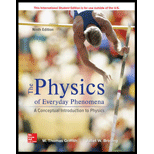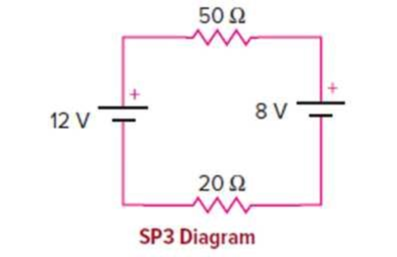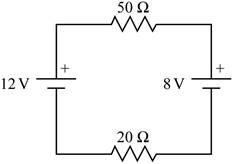
In the circuit shown, the 8-V battery is opposing the 12-V battery as they are positioned. The total voltage of the two batteries will be found by subtracting.
a. What is the current flowing around the circuit?
b. What is the voltage difference across the 20 Ω resistor?
c. What is the power delivered by the 12-V battery?
d. Is the 12-V battery discharging or charging in this arrangement?

(a)
The current flowing in the circuit.
Answer to Problem 3SP
The current through the circuit is
Explanation of Solution
Given info: The given circuit is shown below.

The two batteries in the given circuit have opposite polarity in the circuit. So the net potential difference of the circuit will be the difference of the two potential of the two batteries.
Write the formula for the net potential difference of the circuit.
Here,
The two resistance in the circuit are in series.
Write the formula for the equivalent resistance of the two resistances.
Here,
Write the formula for current.
Here,
Substitute the expression for
Substitute
Conclusion:
The current through the circuit is
(b)
The voltage difference across the
Answer to Problem 3SP
The voltage difference across the
Explanation of Solution
Given info: The given circuit is shown below.

The two batteries in the given circuit have opposite polarity in the circuit. So the net potential difference of the circuit will be the difference of the two potential of the two batteries.
Write the formula for the voltage difference across a resistor when two resistors are in series.
Here,
Substitute
Conclusion:
The voltage difference across the
(c)
The power delivered by the battery with voltage
Answer to Problem 3SP
The power delivered by the battery with voltage
Explanation of Solution
Given info: The given circuit is shown below.

Write the formula for the power delivered.
Here,
From section (a) the current in the circuit is
Substitute
Conclusion:
The power delivered by the battery with voltage
(d)
Whether the battery with voltage
Answer to Problem 3SP
The battery with voltage
Explanation of Solution
Given info: The given circuit is shown below.

The overall voltage of the circuit is
Thus the battery with voltage
Conclusion:
The battery with voltage
Want to see more full solutions like this?
Chapter 13 Solutions
Physics of Everyday Phenomena
- Integrated Concepts (a) What is the average power output of a heart defibrillator that dissipates 400 J of energy in 10.0 ms? (b) Considering the high-power output, why doesn’t the defibrillator produce serious burns?arrow_forwardA 1,00-?O voltmeter is placed in parallel with a 75.0kresistor in a circuit, (a) Draw a circuit diagram of the connection, (b) What is the resistance of the combination? If the voltage across the combination is kept the same as it was across the 75.0-kresistor alone, what is the percent increase in current? (d) If the current through the combination is kept the same as it was through the 75.0-kresistor alone, what is the percentage decrease in voltage? (e) Are the changes found in parts (c) and (d) significant? Discuss.arrow_forwardElectric circuits are sometimes explained using a conceptual model of water flowing through a pipe. In this conceptual model, the voltage source is represented as a pump that pumps water through pipes and the pipes connect components in the circuit. Is a conceptual model of water flowing through a pipe an adequate representation of the circuit? How are electrons and wires similar to water molecules and pipes? How are they different?arrow_forward
- . All of the electrical outlets in a room are connected in a single parallel circuit (Figure 7.38). The circuit is equipped with a 20-A fuse, and the voltage is 120 V. (a) What is the maximum total power that can be supplied by the outlets without blowing the fuse? (b) How many 1,200-W appliances can be plugged into the sockets without blowing the fuse?arrow_forwardConsider the circuits shown below, (a) What is the current through each resistor in part (a)? (b) What is the current through each resistor in part (b)? (c) What is the power dissipated or consumed by each circuit? (d) What is the power supplied to each circuit?arrow_forwardA 12-V car battery is used to power a 20.00-W, 12.00-V lamp during the physics club camping trip/star party. The cable to the lamp is 2.00 meters long, 14-gauge copper wire with a charge density of n=9.501028m3 . (a) What is the current draw by the lamp? (b) How long would it take an electron to get from the battery to the lamp?arrow_forward
- Integrated Concepts A light-rail commuter train draws 630 A of 650-V DC electricity when accelerating, (a) What is its power consumption rate in kilowatts? (b) How long does it take to reach 20.0 m/s stalling from rest if its loaded mass is 5.30 1()4 kg, assuming 95.0% efficiency and constant power? (c) Find its average acceleration. (d) Discuss how the acceleration you found for the light-rail train compares to what might be typical for an automobile.arrow_forwardA 12-V battery is connected across a device with variable resistance. As the resistance of the device increases, determine whether the following quantities increase, decrease, or remain unchanged. Indicate your answers with I, D, or U, respectively. (a) The current through the device. (b) The voltage across the device. (c) The power consumed by the device.arrow_forwardConstruct Your Own Problem Consider a battery used to supply energy to a cellular phone. Construct a problem in which you determine the energy that must be supplied by the battery, and then calculate the amount of charge it must be able to move in order to supply this energy. Among the things to be considered are the energy needs and battery voltage. You may need to look ahead to interpret manufacturer’s battery ratings in ampere hours as energy in joules.arrow_forward
- The label or a portable radio recommends the use of rechargeable nickel-cadmium cells (nicads), although they have a 1.25-V emf while alkaline cells have a 1.58-V emf. The radio has a 3.20- resistance, (a) Draw a circuit diagram ot the radio and its batteries. Now, calculate the power delivered to the radio, (b) When using Nicad cells each having an internal resistance of 0.0400O. (c) When using alkaline cells each having an internal resistance of 0.200 . (d) Does this difference seem significant, considering that the radio s effective resistance is lowered when its volume is turned up?arrow_forwardYou have a faculty position at a community college and are teaching a class in automotive technology. You are deep in a discussion of using jumper cables to start a car with a dead battery from a car with a fresh battery. You have drawn the circuit diagram in Figure P27.16 to explain the process. The battery on the left is the live battery in the correctly functioning car, with emf and internal resistance RL, where the L subscript refers to live. Its terminals are connected directly across those of the dead battery, in the middle of the diagram, with emf and internal resistance RD, where the D subscript refers to dead. Then, the starter in the car with the dead battery is activated by closing the ignition switch, allowing the car to start. The resistance of the starter is RS. A student raises his hand and asks, So is the dead battery being charged while the starter is operating? How do you respond? Figure P27.16arrow_forwardSome makes of older cars have 6.00-V electrical systems. (a) What is the hot resistance of a 30.0-W headlight in such a car? (b) What current flows through it?arrow_forward
 Glencoe Physics: Principles and Problems, Student...PhysicsISBN:9780078807213Author:Paul W. ZitzewitzPublisher:Glencoe/McGraw-Hill
Glencoe Physics: Principles and Problems, Student...PhysicsISBN:9780078807213Author:Paul W. ZitzewitzPublisher:Glencoe/McGraw-Hill Principles of Physics: A Calculus-Based TextPhysicsISBN:9781133104261Author:Raymond A. Serway, John W. JewettPublisher:Cengage Learning
Principles of Physics: A Calculus-Based TextPhysicsISBN:9781133104261Author:Raymond A. Serway, John W. JewettPublisher:Cengage Learning Physics for Scientists and Engineers, Technology ...PhysicsISBN:9781305116399Author:Raymond A. Serway, John W. JewettPublisher:Cengage Learning
Physics for Scientists and Engineers, Technology ...PhysicsISBN:9781305116399Author:Raymond A. Serway, John W. JewettPublisher:Cengage Learning College PhysicsPhysicsISBN:9781938168000Author:Paul Peter Urone, Roger HinrichsPublisher:OpenStax College
College PhysicsPhysicsISBN:9781938168000Author:Paul Peter Urone, Roger HinrichsPublisher:OpenStax College
 College PhysicsPhysicsISBN:9781305952300Author:Raymond A. Serway, Chris VuillePublisher:Cengage Learning
College PhysicsPhysicsISBN:9781305952300Author:Raymond A. Serway, Chris VuillePublisher:Cengage Learning





